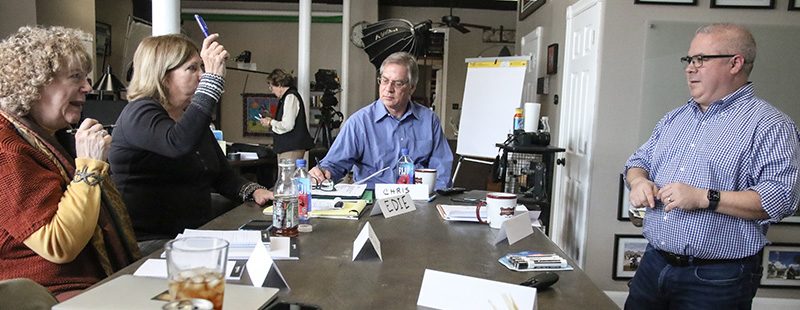Whether you represent a corporation, non-profit, political candidate, product, person, or place, developing a message map through a “Message Mapping Strategy Session” is the most important part of your work to stay on message when talking with the media.
To give context on developing message maps, I was in graduate school studying public relations at Webster University when I took one of my most important classes, “Crisis Communications.” Tripp Frohlichstein, one of the foremost crisis communication experts in the United States, taught it over spring break. We lived through constant crisis scenarios both on-camera and off for the entire week. It was exhausting, but we learned through the intensity the ability to communicate effectively and stay on message through any crisis.
I credit this class as the one where I learned everything I needed to know about public relations – it taught me the true art of messaging, including how to build a communications strategy by developing a message map.
Today, Chemistry PR & Multimedia uses the principles Tripp taught. In fact, whenever our team begins working with a new client, one of the first things we do is to work with the client to develop a message map for them. Beth Fagan, one of Tripp’s business partners, and Chris Kuban facilitates a discussion that typically includes a company or organization’s leadership, board members, or other key stakeholders. And in the session, we find out more about what the company does, what they’re trying to achieve, and what message they want to convey to their audiences.
The result is a message map that will guide the communication strategy and tactics we use as we move forward in our work. More importantly, it helps make sure that everyone involved in communications on behalf of the company has a unifying message and a common way of talking about the company.
What’s a Message Map
In its final form, the message map is a diagram on a single piece of paper. The diagram resembles an airline hub or a spoke map. All directions lead to a single, central message that serve as the base. The spokes on the map come key points that you want employees, product line, customers to know and understand. From a strategy standpoint all these points lead to a focus that addresses a concern for the customer.
Why is a Message Map Important
Chances are your organization has one of two communications challenges. It probably has several stories it could tell and many messages, all of which it wants to convey. Or the organization isn’t sure what its main messages are (or should be), let alone how to get them to your main audience.
The result of these challenges is confusion – confusion about who you are, what you do, and how you address the customer’s needs. Using a message map to distill a single, unifying key message that needs to go to your target audience helps eliminate this confusion.
When you develop your messaging, you must first understand who your identified target audience is and what type of message you want to convey. Your message often boils down to a single idea around how your company helps your customers with a concern they have.
Narrowing you message down to its simplest, most basic concept helps ensure that your communications achieve their single most important objective. By using a message map structure, you can go into an interview with a better understanding of how you need to respond when speaking with a reporter.
Messaging starts with your initial pitch to media. To make the news, your challenge is to tell a compelling story. Always consider the reasons why an editor, reporter or producer should listen to you, and give you credibility by telling your story.
Creating the compelling story is up to you. But explaining it is where most spokespeople begin to stray from the message. If you have a message map, you can filter your response to almost any question back to your key message and ensure that you are getting your point across appropriately.
 Your Key Message is Your Home Base
Your Key Message is Your Home Base
One of the key communication philosophies Tripp Frohlichstein developed is the concept of the “HOME BASE” from which to effectively communicate. And this Home Base becomes the center hub on your message map.
Personally, I love Baseball! And I likened the “Home Base” principle to one of the most important parts of winning a baseball game. A player might hit a home run; he or she might hit a single and a double or even a triple. However, if your entire goal as a public relations professional is to get to Home Base in your communications, you need to start with a Home Base messaging strategy. With this Home Base strategy, you can hit a home run every time you or your client is interviewed.
In relating your message to the “Home Base” principle, your main message needs to be a simple, easy to understand phrase that can be used multiple times throughout your interview. Remember you have a limited amount of time. And a 30-minute interview often gets edited to a 30-second soundbite!
What would you like your message to be? Consistently answering questions with some form of your “Home Base” message will carry more weight and ensure that the main message being conveyed will be heard clearly as the outcome of the produced segment.
Just as a game-day book prepares a team for play or a roadmap guides you to your destination, a message map helps you know what you’ll say and how you’ll say it. The message map combines your Home Base, along with several positive proof points in an easy-to-understand form. And no matter the question you might get from a reporter, you and your spokespeople will always know that their focus should be on your Home Base answer.
Positive Proof Points Bolster Your Key Message
Once you determine who your target audience is and the Home Base message you want or need for them to hear, you’ll probably need to provide some supporting details. Depending on what your key message is, these details could be statistics to support a main idea, further explanation of the Home Base message, or reasons why the Home Base Message is important.
Whatever proof points you use, though, it’s important that you don’t focus on the negative. Focus on the features and benefits or the ways your organization provides help rather than the negative problems that make your organization or its products and services necessary.
Positive points and positive proof points are both qualitative and quantitative statements that are intended to reinforce your Home Base message and prove your statements to be true. For example, if your Home Base message centers on the idea that your product or service is among the best available, you might choose to support that statement with the following ideas:
Positive Point Positive Proof Points
We have Expertise Average Length of Employee Service
Product Reliability Product warranty or guarantee
Competitive Pricing Price Reductions
Assuring Delivery Quality Use of Expensive Packaging
Excellent Customer Service 24-hour Toll-Free Product
In using positive points that distinguish you from your competitors, you’ll need to identify what will resonate most effectively with your target audience. Once you know what types of details matter to your audience, you’ll be able to craft the “spokes” of your message map to support the central Home Base message.
How To Use a Message Map
In baseball, getting to “Home Base” is an important part of winning the game. Whether you hit a single, double, triple, or a home run, your entire goal is to get back to Home Base. When communicating your message, the same is true: no matter what type of question you’re asked, your goal is to always come back to that single cohesive statement. Tying your response to every type of question to your “Home Base” message will ensure you reach your goal of getting your key message across to your audience.
In creating a message map, your main “Home Base” message needs to be a simple, easy to understand phrase that can be used multiple times throughout your interview.
Remember, when you’re talking to the media, whether you have pitched them the story or they’ve reached out to you, the amount of time you’ll have to get your message across is extremely limited. While you might be interviewed for 30 minutes, this interview will likely be edited to a final version of that is only 3 minutes – or even only 30 seconds – long. Consistently answering questions with a variation of your “Home Base” message will ensure that the main message will still come through regardless of the portions of the interview used and the length of the final piece.
Your message development or content should focus on brevity, emotion, positive points, and preparation.
Brevity: The complete thoughts and statements you use to answer a question should be 12 to 20 seconds long for television, 8 to 20 seconds for radio and 40 seconds for print interviews. These are better known as soundbites.
Emotion: What you say is as important as how you say it. Your energy, enthusiasm, excitement, and entertainment factors will instill a strong connection with your audience.
Positive Points: To stay on message, develop positive points, themes, and messages and use them frequently throughout an interview.
Preparation: Be well rehearsed with facts, figures, statements, taglines, and your key messages to truly make a difference in the outcome of your interview.
A message map and these principles for crafting a “Home Base” message are useful whether you’re promoting your company’s newest product, making a big announcement, or responding to a crisis.
When a crisis hits, though, using a message map and repeatedly returning to your “Home Base” message is vitally important. Remember that, when responding to a question from the media, “No comment” is NEVER an acceptable response. Using a message map to understand how to funnel your responses back to your Home Base will help you be able to tell your story calmly and effectively and in as positive a manner as possible.
 Chris Kuban started Chemistry PR and Multimedia with a vision to effectively formulate corporate and non-profit brands across the country. He is an expert in Media Relations, Event Management and video production. Working with a team of local and national suppliers, vendors, employees, and consultants has allowed him to coordinate more than 246 national events that help deliver the ROI his clients seek. Follow him on Twitter or connect with him on LinkedIn. Chris is proud that his firm is ranked one of the Best St. Louis Public Relations Firms in the region.
Chris Kuban started Chemistry PR and Multimedia with a vision to effectively formulate corporate and non-profit brands across the country. He is an expert in Media Relations, Event Management and video production. Working with a team of local and national suppliers, vendors, employees, and consultants has allowed him to coordinate more than 246 national events that help deliver the ROI his clients seek. Follow him on Twitter or connect with him on LinkedIn. Chris is proud that his firm is ranked one of the Best St. Louis Public Relations Firms in the region.



